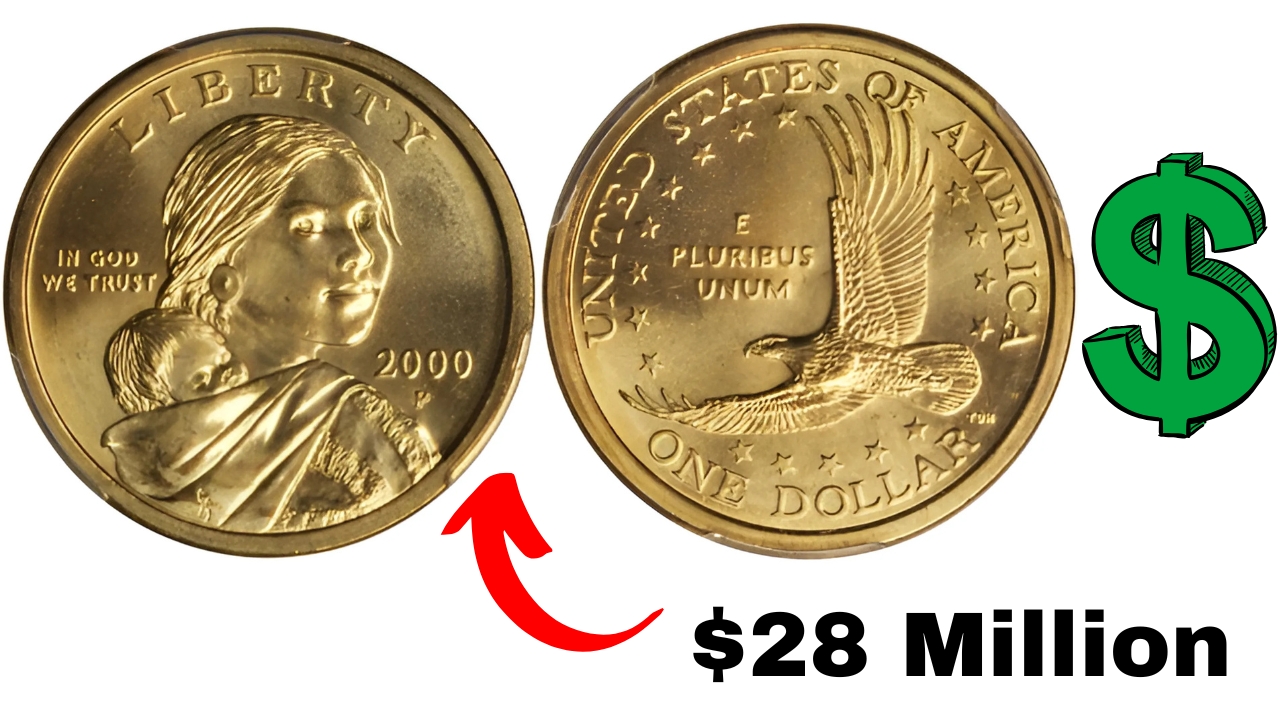Rare coin: That loose change jingling in your pocket or hidden away in an old jacket might seem trivial—coins like pennies and nickels hardly seem worth counting.
However, within that stack of everyday coins could lie an extraordinary treasure, transforming the simple act of checking your change into an exciting potential discovery.
In the realm of American coinage, certain rare coins command astonishing prices that can be truly mind-blowing. For instance, some of the most sought-after examples could potentially fetch as much as $28 million if they come up at auction today.
In the prestigious world of coin collecting, none shines brighter than the legendary 1913 Liberty Head nickel.
With only five known specimens in existence, this particular coin embodies a unique mix of rarity, mystery, and allure that drives collectors to go to remarkable lengths—and spend staggering amounts.
“The 1913 Liberty Head nickel isn’t just rare; it defies reason—it shouldn’t even exist,” remarks Marcus Davidson, a seasoned expert in numismatics who has dedicated over three decades to studying American coins.
“By 1913, the Mint had officially switched over to producing the Buffalo nickel. Yet still, somehow, five Liberty Head nickels dated for that year were minted under enigmatic circumstances. This unauthorized production has created what many regard as the most famous American coin.”
The most recent public sale of a 1913 Liberty Head nickel occurred in 2010, when the renowned Olsen specimen was sold for an impressive $3.7 million.
Experts believe that, given the current market dynamics—where demand from collectors is high and the supply of investment-worthy rarities is low—a pristine specimen could very well command between $20 million and $28 million at auction, especially if its provenance is linked to celebrated collectors like Louis Eliasberg or King Farouk of Egypt.
While the chances of stumbling upon one of these five famed specimens in circulation are incredibly slim, their existence reminds us of a vital point about American coinage: extraordinary value can sometimes be hidden within pieces that seem ordinary, and unexpected discoveries can still happen.
Rare coin Pocket Change Treasures Within Reach
While the 1913 Liberty nickel epitomizes the ultimate goal for coin collectors, many other rare coins possess significant value and remain tantalizingly possible to uncover in everyday transactions or as part of inherited collections.
A prime example of such a treasure is the 1969-S Lincoln cent with a doubled die obverse, which stands out as particularly captivating.
This coin became famous when the die used to stamp it was misaligned during production, leading to distinct doubling on both the date and letters that can be observed without a magnifying glass.
With fewer than 100 authenticated examples known, these coins often fetch between $50,000 and $75,000 at auctions, depending on their condition.
“What’s truly fascinating about the 1969-S doubled die penny is that it circulated normally,” shares Elizabeth Chen, the curator of American coinage at a leading East Coast museum. “People found them in their change, often years after they were produced.
Some lucky collectors who recognized their significance early managed to buy multiple examples directly from bank rolls, turning a small investment into a fortune.”
The 1972 Lincoln cent also presents a similar doubled die variety, selling for between $500 and $3,000 based on its condition, which is a remarkable return for a coin still occasionally seen in circulation.
Even quarters can yield surprising value. The 1932-D and 1932-S Washington quarters, the first issued in their series, had relatively low mintages.
Spotting one amidst pocket change remains a possibility, with values ranging from $100 for worn examples to upwards of $5,000 for those showing minimal signs of circulation.
Additionally, recent error coins, particularly those related to state quarters, have piqued the interest of collectors.
For example, the 2004-D Wisconsin quarter featuring an extra “leaf” on the corn stalk sells for $200 to $500, while certain off-center strikes or those made from the wrong planchet can fetch thousands, depending on the nature and severity of the error.
Rare coin The Detective Work of Coin Hunting
Uncovering valuable coins involves developing a keen eye for the details that separate the ordinary from the extraordinary.
Paying attention to date and mint mark combinations is top priority, as certain years and mints yield inherently scarcer pieces due to limited production runs or historical events.
“The mint mark—a small letter indicating where the coin was produced—can often be the decisive factor,” explains Robert Thompson, who turned a casual interest in coin collecting into a thriving career after discovering a rare die variety in a roll of nickels from his local bank.
“For example, a 1950-D Jefferson nickel might be valued at $20 or more in circulated condition, while a much more common 1950 or 1950-S could be worth just its face value unless it’s in mint condition.”
Mint marks are typically found on the obverse (front) or reverse of coins, with their positions varying by year and denomination.
In modern coins, check for the tiny letter beneath or next to the date—D for Denver, S for San Francisco, with no mint mark signifying Philadelphia production for most of American history.
Besides date and mint marks, error coins—items that feature manufacturing mistakes—are often highly sought after.
This includes off-center strikes, double strikes, missing design elements, and other irregularities that create unique pieces collectors are eager to find.
“You don’t need expensive equipment to begin identifying potentially valuable coins,” Davidson says. “A reliable magnifying glass, good lighting, and reference materials on key dates and error varieties will serve beginners well.
The United States Mint has produced billions of coins, but knowing which specific dates, mint marks, and errors to look for significantly narrows your search.”
Rare coin Where to Hunt for Numismatic Treasure
Your quest for valuable coins can start with the change you already have. Examine each coin closely, especially older pieces that may exhibit distinctive wear patterns or peculiar features.
Be particularly vigilant with pennies and nickels, which typically stay in circulation longer and are more likely to contain potential treasures from earlier decades.
Bank rolls present another great opportunity for treasure hunting at minimal cost. For about $25, collectors can buy a roll of half-dollars that may contain silver coins minted before 1964, or 40% silver coins produced between 1965 and 1970.
Searching through rolls of cents might uncover wheat pennies (minted from 1909 to 1958) or even the occasional Indian Head penny that has resurfaced from retired collections.
Family collections handed down through generations often hide overlooked gems.
These inherited stocks might include coins once set aside years ago when certain dates and mint marks were still in circulation, but have since vanished from everyday use.
“I’ve seen many collections that families thought contained only common coins, only to find individual pieces valued in the thousands,” Chen reveals.
“One particularly memorable situation involved a Mason jar filled with what looked like ordinary pennies. Intermixed with them were three 1909-S VDB Lincoln cents, valued at around $1,000 each, even in their worn state.”
Estate sales, flea markets, and even antique shops can also yield significant discoveries for those knowledgeable in the field.
Coins misidentified or priced solely based on face value instead of collector value can offer substantial returns for minimal investments.
Rare coin Preservation and Authentication
Once you discover potentially valuable coins, it’s crucial to handle them with care. Avoid cleaning coins with abrasive materials, harsh chemicals, or even soap and water.
The natural surfaces, including the original toning and patina accumulated over decades, significantly contribute to the coin’s authenticity and value.
“The initial reaction upon discovering what seems to be a valuable coin is often to clean it—which is exactly the wrong instinct,” warns Thompson.
“A coin that has been cleaned can lose a massive chunk of its potential value, often between 50% and 90% when compared with coins retaining their original surfaces.”
For coins that might hold significant value, professional authentication through organizations like Professional Coin Grading Service (PCGS) or Numismatic Guaranty Corporation (NGC) offers reassurance regarding authenticity and condition evaluation.
These services can encapsulate coins in tamper-evident holders, ensuring authenticity and easing the selling process while boosting buyer confidence.
Rare coin The Ongoing Treasure Hunt
The thrill of uncovering extraordinary value hidden within seemingly ordinary coins ensures that numismatics—the study and collection of currency—remains one of America’s most cherished and approachable hobbies.
Discovering a $28 million nickel may be a daunting prospect, but finding coins valued in the hundreds or thousands remains entirely achievable with diligence, knowledge, and an eye for detail.
“Every collection starts with that one coin that piques a person’s interest,” reflects Davidson. “The beauty of this hobby is that potential treasures are continuously circulating through our daily transactions.
So, the next time you receive change, take a moment to closely examine those coins. You never know what might be waiting for you in plain sight.”
Whether driven by the excitement of potential investment, an appreciation for history, or simply the thrill that comes with the hunt, looking carefully at your pocket change transforms a routine occurrence into an adventure with real opportunities for discovery.
That long-forgotten jar of coins collecting dust could either contain common change—or it might just be hiding a life-altering treasure waiting for someone sharp enough to see its true value.






